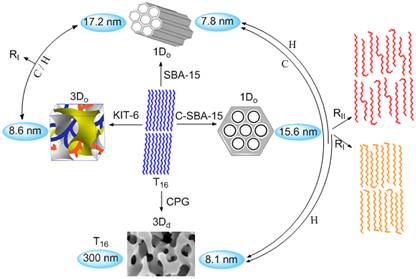Phases of fluids under nanoconfinement are the structural basis of physical properties of soft matter confined in nanospace. However, existing state of the molecules, phases and phase changes of the nanoconfined fluids may be very different in bulk referred to. In the case, the freezing and melting in nanospace can be very complicated, which becomes a heated topic in this field. A team from College of Chemistry and Material Science, Shandong Agricultural University chose normal alkane hexadecane (n-C16H34) as model compound and absorbed it into several porous materials. They investigated the phase behaviors of n-C16H34 at different pore size, polarity of pore wall and pore morphology. Their research is published in The Journal of Physical Chemistry C on July 22nd, 2015.
The team found the melting points of C16 in the nanopores are depressed, which varied largely with the pore size, the nature of the pore wall, and pore morphology. In the pores of CPG (300 nm), n-C16 shows only the triclinic phase as the bulk. While in SBA-15 (7.8 nm), CPG (8.1 nm), and C-SBA-15 (15.6 nm), rotator phase RI and RII appeared on cooling and heating, except that RII was not observed on heating in CPG (8.1 nm). The presence and the existing temperature range of these new rotator phases are associated with the pore diameter, interface interaction and pore geometry.

Some crystal structures of the normal hexadecane in nanopores are gained through using the synchrotron radiation at BSRF. Combined with low temperature DSC method, the crystalline structure and phase sequence of the alkane may be decided. The global phase diagram of pure alkanes can be obtained in respect to different size and interface interaction.
Article:
Wang, L. P.; Sui, J.; Zhai, M.; Tian, F.; Lan, X. Z.*, Physical Control of Phase Behavior of Hexadecane in Nanopores. The Journal of Physical Chemistry C 2015, 119 (32), 18697-18706.


